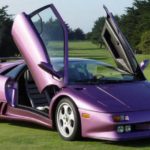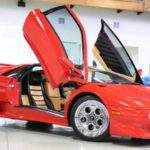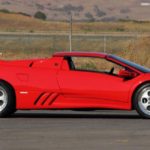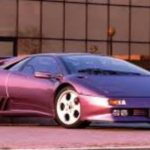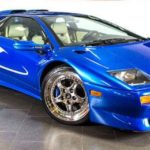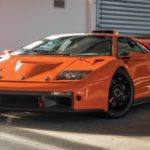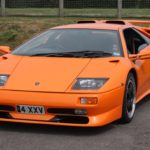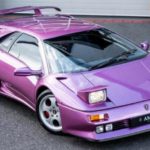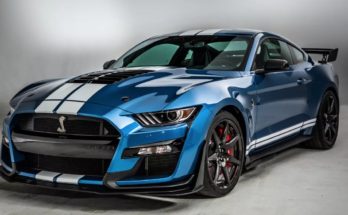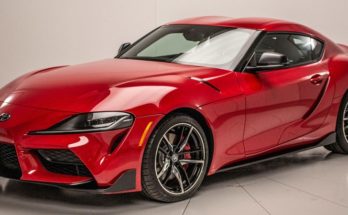Though some people might shy away from something named as this car is, the Lamborghini Diablo proved popular enough to last for over a decade, from 1990-2001. With almost 3,000 units produced, the two-door, high performance sports car (available as a coupe or roadster) is still turning heads and impressing car enthusiasts around the world.
Its history, however, was somewhat troubled, as the original designer Marcello Gandini’s vision of sharp lines gave way to Tom Gale’s softer shaping (Gandini would later take his unique design and turn it into the Cizeta-Morodor V16T). After spending an alleged 6 billion lira on development, the Diablo was ready to roar.
The Diablo, like other Lamborghini models, took its name and inspiration from the sport of bullfighting. Named after the original “Diablo”, a bull raised by the Duke of Veragua in the late 1800’s, the vehicle too was made to fight — or at least to compete on the market, especially with the Ferrari. Though the bull was famous for its fight with “El Chicorro” in Madrid in 1869, the Diablo Lamborghini became famous as a show-stopper first, and then a fighter, as the Lamborghini brand did not race as street legal cars until the mid 1990’s, though it surpassed the 200 mph mark, the first Lamborghini to do so.
With over a decade spent as the Countach’s successor, the Diablo itself went through a variety of changes, upgrades, and redesigns before being succeeded itself by the Murcielago. The Diablo VT, introduced just two years after the original appeared on the market, used all wheel drive and a viscous center differential, as well as adding front air intakes and enlarging the back air intakes. These and other minor changes (including a redesigned interior) were soon transferred to the original build, making the cars, at least on the surface, appear the same.
The Diablo SE30 and SE30 Jota appeared during Lamborghini’s 30th anniversary, as a street legal racing car and a circuit racing car, respectively. With less weight on the build and more power, the SE30 and SE30 Jota were sent to the racetrack and road roaring past their competitors and fans alike. The Diablo SV, introduced in 1995 at the Geneva Auto Show, was available in both SV and SV: Monterey Edition. The Monterey build was driven by Mario Andretti for a “Running of the Bulls” event in California. The SV has the distinction of being the flagship vehicle for the game Need For Speed III: Hot Pursuit. Another version introduced in 1995 was the Diablo VT Roadster, complete with a carbon fiber targa top, larger air intakes, and fixed headlights, the last of which meant the Roadster was more aerodynamic.
In 1999, the Diablo models SV, VT, and VT Roadster received facelifts, with minor upgrades. 1999 was also the year the world was introduced to the Diablo SE35, a nine-car limited edition production celebrating the 35th anniversary of Lamborghini, and the Diablo GT, which was made exclusively for racing (only 80 were produced, and were only available in Europe).
The last hurrah for the Diablo was the production of the VT 6.0 and VT 6.0 SE, which led up to their replacement by the Murcielago. The VT 6.0 SE came in only two colors, one reminiscent of a sunrise (Oro Elios) and the other reminiscent of a sunset (Marrone Eklipsis).
Though the Diablo was never big in racing, there were two editions that did take part in the sport – the SV-R (noted as the first Lamborghini to be made for racing), which took part in the Lamborghini Supertrophy, and the GTR, which was driven by Paul Stokell and won the 2003 and 2004 Australian Nations Cup Championship.
Despite it being replaced, the Lamborghini Diablo lives on in the minds and hearts of collectors around the world, and will continue to be, as Jeremy Clarkson of Top Gear stated, “…the biggest head-turner in the world.”
 " >
" >
